What sets the snow leopard apart in the wilds of Central Asia? Adapting to life at high altitudes, snow leopards navigate a world of extreme cold and rugged terrain. This article explores their habitat, behavior, and the significant conservation challenges they face, providing a concise look into the life of these remarkable yet vulnerable predators.
Key Takeaways
The Snow Leopard is an apex predator in high-altitude ecosystems of Central Asia. It is adapted to its harsh, cold, and rough terrain and has various physical traits, such as expansive paws, thick fur, and short ears.
With an estimated population of 4,080 to 6,590 individuals, Snow Leopards face multiple threats, such as habitat loss, human-wildlife conflict, decreased availability of natural prey, and poaching, leading to their ‘vulnerable’ conservation status.
Conservation efforts for Snow Leopards involve international collaboration through programs like GSLEP, legal protections, community-based strategies to mitigate human-wildlife conflict, and comprehensive research and monitoring to guide preservation actions.
The Mystique of the Snow Leopard
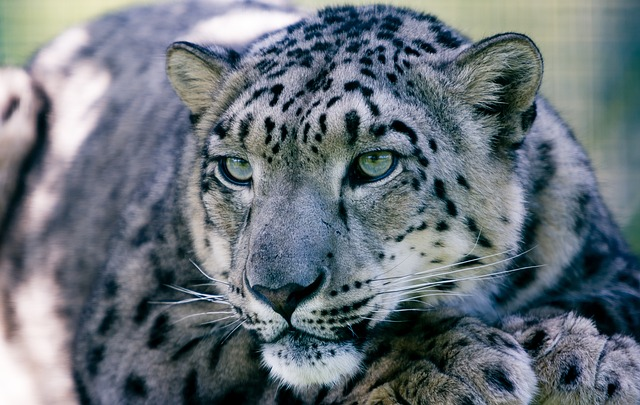
Often veiled in the shadows of the Himalayas, the Snow Leopard is an enigma. Dubbed the ‘ghost of the mountains,’ these big cats are a rare sight even for the most avid wildlife observers. Their coat, a swirling pattern of dark rosettes set against a pale background, acts as a natural cloak against their mountainous home’s snow and rocky outcrops. As one ventures into the realm of these large cats, it’s not just their physical appearance that captivates, but also the rich history behind their name. The term’ ounce’ has a storied past, originating from the Latin ‘luna’ for lynx, evolving through various languages, and eventually becoming ‘ounce’ in English, shedding the initial ‘l’ in the process.
Known occasionally as the ‘ounce,’ the elusive snow leopard is an apex predator, ruling the high-altitude ecosystems of Central Asia with silent dominance. Their ability to move as a whisper across the cliffs and deep valleys has long fueled local legends and folklore. Within the silence of these landscapes, the snow leopard’s reign is supreme, a ghostly figure that leaves behind only the faintest of footprints in the snow.
The Natural Home of Snow Leopards
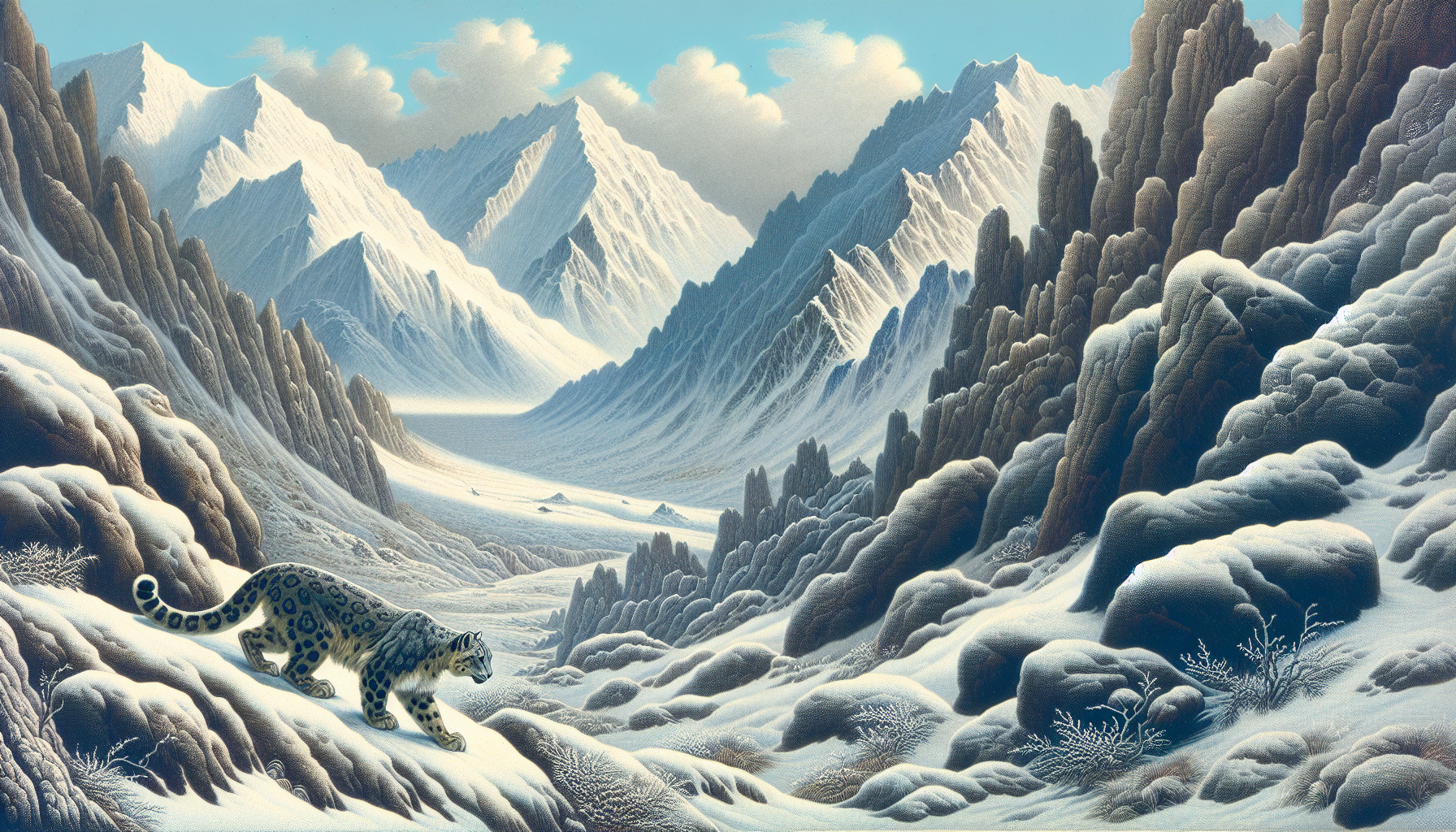
The Snow Leopard’s habitat mirrors the cats’ dramatic and formidable nature. These big cats are adapted to life high in the Mountains of Central Asia, where the rugged terrain and sparse vegetation have shaped their evolution over millennia. Across 12 countries, including:
Mongolia
Nepal
Pakistan
Russia
Their habitat is an expansive 2,000,000 square kilometers, with each region offering a unique backdrop for the Snow Leopard’s existence.
Their typical climate is unforgiving, cold, and dry, supporting only grasses and small shrubs on steep mountain slopes that challenge even the hardiest species. However, in these harsh environments, Snow Leopards manage to not just survive but excel, thanks to their remarkable terrain and climate adaptations.
Preferred Terrain
Snow Leopards prefer broken terrain, offering a natural advantage for hunting and evading detection. The potential Snow Leopard habitat is a spectacular collage of jagged rocks and steep slopes, found predominantly at elevations around 4,000 meters above sea level. These high-altitude landscapes, including the famed Tibetan Plateau, afford Snow Leopards the perfect vantage points and hiding spots necessary for survival. They select bedding sites with expansive views, allowing them to meticulously survey their rocky environment for any sign of prey or threat. In these habitats, snow leopards thrive, making the most of their unique surroundings.
The terrain also significantly influences their hunting strategy. The uneven ground and only grasses for cover make it easier for Snow Leopards to stalk their prey undetected. Their agility and prowess in such terrain are unparalleled, allowing them to navigate the mountains with a grace that belies their power.
Climate Adaptations
In the face of the harshest conditions, the Snow Leopard’s physical adaptations reveal a creature perfectly attuned to its environment. Some of these adaptations include:
Expansive paws that act like natural snowshoes, enabling them to tread lightly on deep snow and move with silent, ghost-like grace.
It has rounded, short ears that minimize heat loss.
Wide, short nasal passages that warm the air before it reaches the lungs, a testament to their evolution in the cold.
Thick, insulating fur that becomes a protective layer against the biting cold as winter sets in.
These adaptations help the Snow Leopard survive and thrive in its harsh habitat.
These big cats also possess a stocky build, thick fur and small rounded ears, all of which are key adaptations to conserve heat in their frigid mountain habitats. The palette of whites, greys, and blacks in their coat provides warmth and blends seamlessly into the snowy backdrop, making them almost invisible to prey and onlookers.
Identifying Snow Leopards
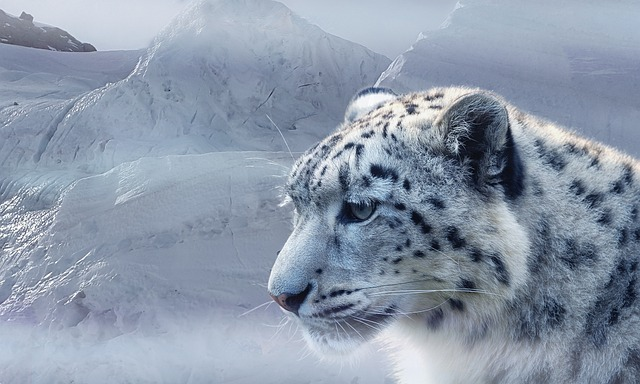
The Snow Leopard’s coat is an artistic marvel of natural camouflage. Ranging in color from smoky grey to a light yellow-tan, it provides both insulation against the cold and a stealthy disguise. The pattern of solid spots and rosettes is more than just a beautiful trait; they’re an essential part of the Snow Leopard’s survival toolkit, allowing them to blend into their habitat’s rocky and snowy landscape. Each Snow Leopard boasts a unique pattern, making it possible to distinguish one cat from another in the wild, much like a fingerprint.
While their long, thick fur and patterned camouflage are instrumental in their hunting prowess, wild cats also contribute to the mystique that surrounds these animals. Their ability to disappear into their surroundings has made sightings of these big cats rare and magical, further cementing their status as the phantoms of the peaks.
The Diet of a Mountain Predator
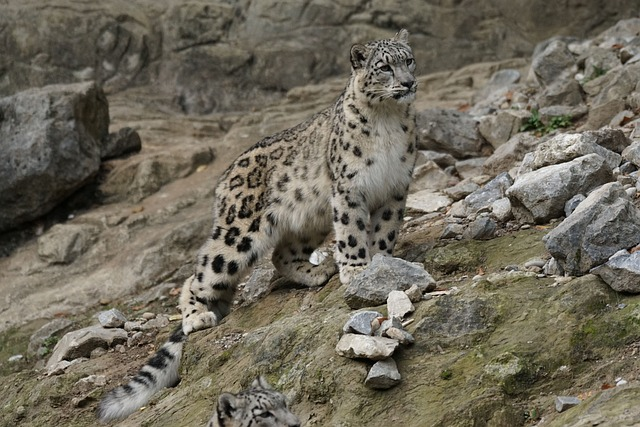
Snow Leopards are pure carnivores, and snow leopards eat herbivores inhabiting the mountainous terrain where snow leopards live. The Himalayan blue sheep tops the list, providing a substantial meal to sustain the big cat for weeks. Their hunting strategy is of patience and precision, striking most often at dawn and dusk when the light is low, and their natural camouflage is most effective. Hunting snow leopards is not only illegal but also a threat to the survival of this magnificent species. Snow Leopards are powerful predators, capable of taking down prey up to three times their body weight and going to great lengths to protect their kill from other animals.
However, Snow Leopards’ diets also reflect the pressures they face in the wild. When their natural prey becomes scarce, often due to unsustainable hunting practices, Snow Leopards are forced to turn to domesticated animals. This shift causes conflict with local communities and threatens the balance of the ecosystem that supports both the leopard and its wild prey.
The Solitary Life of Snow Leopards
Individual snow leopards exemplify solitude, usually seen with others only during the mating season or when raising their young. Their communication is subtle and indirect, often involving leaving markings on the landscape, such as scraped ground and sprayed urine against rocks, to signal their presence and territory to other snow leopards. Occasionally, a snow leopard’s roar echoes through the mountains.
Their solitary nature extends to their territorial behavior. Males fiercely guard their ranges from other adult males while allowing overlaps with female territories.
Home Range and Movement
The home territories of Snow Leopards, also known as the snow leopard’s home range, span vast and diverse landscapes. An individual’s territory can range from a compact 30-65 km² to an expansive 1,000 km², shaped by the availability of prey and the need for solitude. The males, in particular, establish exclusive home ranges, often covering up to 100 square kilometers, marking their domains to avoid encounters with competing males.
Within these territories, Snow Leopards are nomadic, constantly searching for prey. They follow ridge lines and cliff bases, offering concealment and a strategic hunting advantage. Their movement patterns are unpredictable, and on occasion, a Snow Leopard may traverse vast distances in a single night, covering terrains as disparate as ridge tops and open deserts.
Despite their preference for solitude, they do not have fixed dens, choosing instead to rest in different locations each night as they track their prey across the mountains.
Reproductive Habits
The mating rituals of Snow Leopards reflect their otherwise solitary nature. They come together only during the breeding season, typically from January to mid-March, with males and females briefly traveling in pairs. After a gestation period of about 93-110 days, the female gives birth in a sheltered den, usually in June or July, to a litter of two to three cubs. These cubs are born blind and completely dependent, opening their eyes after a week and relying on their mother’s milk before transitioning to solid food at two months.
The mother is solely responsible for raising the cubs, teaching them to hunt and navigate the treacherous mountain terrain. The growth journey lasts 18 to 24 months, after which the young leopards disperse to establish their territories and continue the solitary life that defines their species.
Conservation Status: How Many Snow Leopards Remain?
Wildlife advocates worldwide are deeply concerned about the Snow Leopard’s conservation status. With an estimated 4,080 to 6,590 individuals remaining in the wild, the species is categorized as ‘vulnerable’ by the IUCN. Despite this alarming figure, there are glimmers of hope. For instance, Bhutan reported an increase in their Snow Leopard population from 96 individuals in 2016 to 134 in 2023, indicating positive outcomes from conservation efforts.
However, Snow Leopards’ threats are multifaceted, including habitat loss, human-wildlife conflict, decreased availability of natural prey, and ongoing poaching, which sees an average of one leopard killed daily. The fight to protect these majestic creatures is complex, requiring legal measures, international collaboration, and advocacy to increase population assessments and enforcement of conservation laws.
Human-Wildlife Conflict and Its Impact
The encroachment of human settlements into the mountains brings challenges for Snow Leopards. Habitat loss and degradation, driven by human settlement and increased livestock grazing, are encroaching on the Snow Leopard’s habitat, leading to dire consequences. In many regions, herding livestock is the backbone of the local economy, and the loss of animals to Snow Leopard predation can be economically devastating. This often leads to retaliatory killings, which account for more than half of all Snow Leopard deaths, as herders seek to protect their livelihood.
The balance between protecting the Snow Leopard and addressing the needs of local communities is delicate. Conservationists are working to find sustainable solutions that protect both the big cats and the economic interests of those who share the mountains with them.
Initiatives for the Future of Snow Leopards
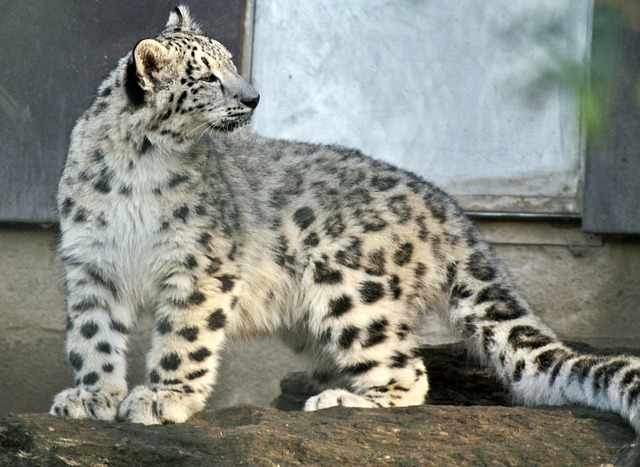
The conservation initiatives for Snow Leopards are as varied as the regions they call home. The Global Snow Leopard and Ecosystem Protection Program (GSLEP) exemplifies international collaboration, bringing together governments, NGOs, and international organizations to safeguard Snow Leopard habitats.
Local community engagement is pivotal, and programs that reduce human-wildlife conflict show promise in conserving Snow Leopard populations. Innovative solutions, from improved livestock protection measures to community-based conservation programs, are being implemented to ensure the snow leopard’s future.
Legal Protections
The struggle to protect Snow Leopards extends from the courtroom to the mountains. Legal frameworks are being strengthened across Snow Leopard range countries to combat poaching and habitat destruction. For instance, in Bhutan, any harm against Snow Leopards is considered a felony, reflecting the stringent protections these animals are afforded under the Forests and Nature Conservation Act of 2023.
These legal measures are critical to conservation efforts, deterring illegal activities and ensuring Snow Leopards receive the highest protection possible. International cooperation is key, as Snow Leopards do not recognize borders, and their protection requires a concerted effort across all nations within their range.
Research and Monitoring
A thorough understanding of Snow Leopards is key to their effective protection. Research and monitoring are pivotal in guiding conservation strategies and providing insights into population dynamics and ecosystem health. For example, Bhutan’s National Snow Leopard Survey employed 310 camera traps across 2.2 million acres, yielding invaluable data on these elusive cats. Organizations like the Snow Leopard Trust and Wildlife Conservation Society have advanced our knowledge of Snow Leopard ecology through dedicated research efforts.
Institutions like the University of Central Asia contribute to the GSLEP program with crucial research that informs conservation decisions. Some of the ways they contribute include:
Conducting genetic studies to assess the health and diversity of Snow Leopard populations
Providing data and information that helps in making conservation decisions
Collaborating with other organizations and researchers to share knowledge and expertise
This research is critical for the long-term conservation of Snow Leopards.
Cultural Significance Across its Range
The Snow Leopard is not just a marvel of nature but also a symbol of cultural pride and significance throughout its range. In countries like the Kyrgyz Republic and Afghanistan, the Snow Leopard is a national emblem, representing qualities such as courage and resilience that resonate with the national psyche. In Bhutan, the Snow Leopard graces traditional art and is a mascot for educational institutions, emphasizing its role in conservation and cultural heritage.
The names given to the Snow Leopard in different languages, such as ‘Heung chituwa’ in Nepal and ‘Irbis’ in Russia, reflect the deep respect and reverence these animals command among local populations. The Snow Leopard’s presence in art, folklore, and national symbols underscores its integral role in the cultural fabric of Central Asia and beyond.
Summary
As we reach the summit of our exploration into the world of the Snow Leopard, we are reminded of the resilience and beauty of these magnificent creatures. We’ve traversed their rugged terrains, understood their solitary and nomadic ways, delved into their diet and hunting strategies, and recognized the significance of their conservation. The Snow Leopard, a symbol of the untamed wilderness, faces a future that hangs in the delicate balance between human expansion and the efforts of those committed to preserving these big cats for generations to come.
Let this journey inspire a collective commitment to the Snow Leopard’s plight. As global citizens, we can support conservation efforts, respect these animals’ habitats, and foster a world where the ghost of the mountains continues to thrive. Through continued research, community engagement, and legal protections, there is hope for the Snow Leopard—a hope that requires unwavering dedication and international cooperation.
Frequently Asked Questions
Where do snow leopards live specifically?
Snow leopards live in the mountain ranges of Central and South Asia, with their habitat spanning across 12 countries, including China, Afghanistan, India, and Russia. About 60% of their habitat is found in China.
Why are snow leopards so pretty?
Snow leopards are considered pretty because their thick white-gray coat spotted with black rosettes provides incredible natural camouflage, making them almost invisible.
Are snow leopards aggressive?
Snow leopards are not aggressive towards humans and are more likely to run away than to defend when disturbed while feeding. There has never been a verified snow leopard attack on a person.
How many snow leopards are left in the world?
Only 3,920 and 6,390 snow leopards are left in the wild despite their habitat range covering 2 million km2.
How rare is a snow leopard?
Snow leopards are rare, with an estimated population of 4,080-6,590 in the wild. The IUCN lists them as ‘vulnerable’.

